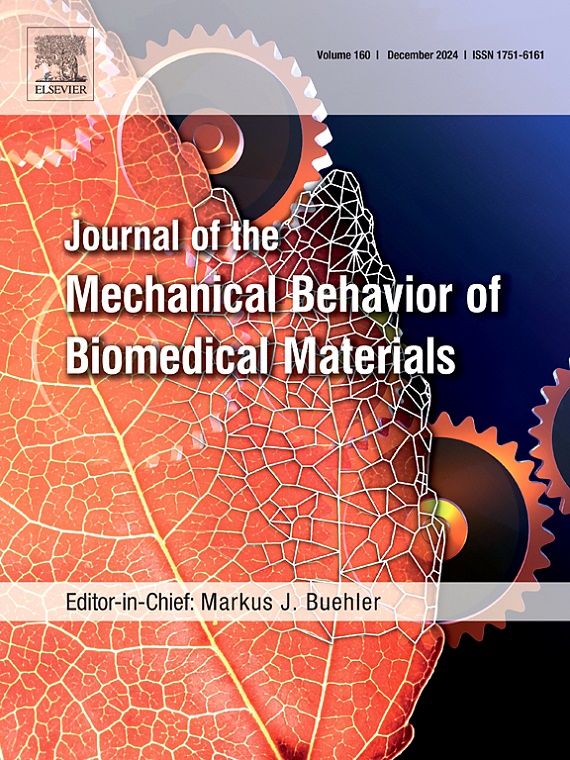膝关节牵张治疗胫股骨关节炎的轴向载荷下膝关节牵张装置的力学评价-一项尸体研究
IF 3.5
2区 医学
Q2 ENGINEERING, BIOMEDICAL
Journal of the Mechanical Behavior of Biomedical Materials
Pub Date : 2025-06-04
DOI:10.1016/j.jmbbm.2025.107098
引用次数: 0
摘要
目的膝关节牵张术是一种治疗年轻患者(45-65岁)胫股骨关节炎的方法,目的是通过分离股骨和胫骨来卸载软骨。KneeReviver是专门为这种治疗开发的设备。虽然KneeReviver已被证明对某些患者是成功的,但结果因患者而异,这表明需要更深入地了解其机械行为。本研究旨在探讨在不同轴向载荷作用下,膝关节支架的力学工作原理。设计一项实验研究,使用5个尸体膝盖,在0、1.2、1.5和3倍体重的轴向载荷下,测量胫骨股骨接触压力、关节间隙宽度变窄和弹簧压缩,有和没有膝关节。结果发现,在所有5具尸体的所有载荷中,KneeReviver有效地降低了接触参数(峰值压力、平均压力、接触面积和软骨载荷)。然而,在拐杖行走时的生理负荷(1.2倍体重)下,关节空间不能完全维持。弹簧压缩随着载荷的增加而增加,达到体重的1.2倍,但在更高的载荷下保持不变。结论本研究证实了膝关节静脉的卸荷作用。然而,它也表明在治疗期间关节间隙没有完全保持。此外,本研究还表明,骨钉的弹性变形比内部装置弹簧的压缩对关节间隙缩小的作用更显著。本文章由计算机程序翻译,如有差异,请以英文原文为准。
Mechanical evaluation of the KneeReviver device under axial loading in knee joint distraction therapy for tibiofemoral osteoarthritis treatment – a cadaver study
Objective
Knee joint distraction is a treatment for younger patients (ages 45–65) with tibiofemoral osteoarthritis, aimed at unloading cartilage through separation of the femur and tibia. The KneeReviver is a device specifically developed for this kind of treatment. While the KneeReviver has proven successful for some, the results vary among patients, highlighting the need for a deeper understanding of its mechanical behavior. This study aims to investigate the mechanical working principle of the KneeReviver under varying axial loads.
Design
An experimental study using five cadaveric knees measured tibiofemoral contact pressures, joint space width narrowing, and spring compression under axial loads of 0, 1.2, 1.5, and 3 times body weight, with and without the KneeReviver.
Results
It was found that the KneeReviver effectively reduced contact parameters (peak pressure, mean pressure, contact area, and load on cartilage) across all loads in all five cadavers. However, at physiological loading while walking with crutches (1.2 times body weight), the joint space was not fully maintained. Spring compression increased with loading up to 1.2 times body weight but remained constant at higher loads.
Conclusions
This study confirmed the unloading effect of the KneeReviver. However, it also showed that the joint gap is not fully maintained during the treatment. Furthermore, this study also showed that elastic deformation of bone pins plays a more significant role in joint gap narrowing than the compression of internal device springs.
求助全文
通过发布文献求助,成功后即可免费获取论文全文。
去求助
来源期刊

Journal of the Mechanical Behavior of Biomedical Materials
工程技术-材料科学:生物材料
CiteScore
7.20
自引率
7.70%
发文量
505
审稿时长
46 days
期刊介绍:
The Journal of the Mechanical Behavior of Biomedical Materials is concerned with the mechanical deformation, damage and failure under applied forces, of biological material (at the tissue, cellular and molecular levels) and of biomaterials, i.e. those materials which are designed to mimic or replace biological materials.
The primary focus of the journal is the synthesis of materials science, biology, and medical and dental science. Reports of fundamental scientific investigations are welcome, as are articles concerned with the practical application of materials in medical devices. Both experimental and theoretical work is of interest; theoretical papers will normally include comparison of predictions with experimental data, though we recognize that this may not always be appropriate. The journal also publishes technical notes concerned with emerging experimental or theoretical techniques, letters to the editor and, by invitation, review articles and papers describing existing techniques for the benefit of an interdisciplinary readership.
 求助内容:
求助内容: 应助结果提醒方式:
应助结果提醒方式:


